It was one of those late June summer evenings in northern India when even the setting of the Sun fails to provide relief from hot and sultry conditions. In the company of the legendary Ali Hussain (an ornithologist in his own way and an expert bird trapper for research purposes), his son Sikandar Hussain (an expert bird trapper), then colleague Rahul Talegaonkar (currently with FES) and field collaborator Bridesh Kumar, we had laid noose traps in and around the breeding territory of an adult male Bengal Florican in Uttar Pradesh’s Dudhwa National Park in the year 2015. This species is a critically endangered obligatory grassland habitat bird of the bustard family, with an estimated global population of less than a thousand individuals. We hoped to place satellite transmitters on the birds to track their movements, which were unknown at the time.
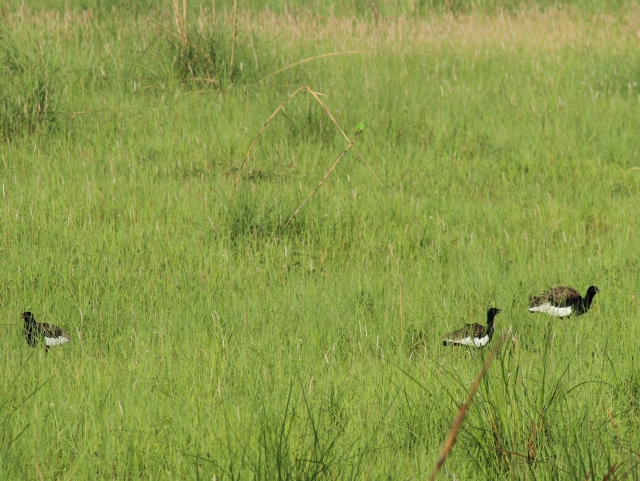 A Bengal Florican lekking site at Pilibhit Tiger Reserve – three adult territorial male Bengal Floricans show aggressive behaviour towards each other during the summer breeding season (2015). Photo by: Rohit Jha
A Bengal Florican lekking site at Pilibhit Tiger Reserve – three adult territorial male Bengal Floricans show aggressive behaviour towards each other during the summer breeding season (2015). Photo by: Rohit Jha
We had been anxiously sitting on treetops at the grassland edge, camouflaged and (hopefully) away from the bird’s view. Our hopes of trapping the bird were fast dimming. The setting Sun had by now painted the sky with a light orange hue mixed with purple streaks, signalling time to remove traps to try another day. But then, against all odds, we saw a male Bengal Florican uncharacteristically trying but failing to take off. We had managed to capture the bird! We ran towards it, unaware of a hog deer that had been hiding from view in tall grass all along, who got spooked by our sudden approach.
We carefully removed the bird’s legs from the harmless noose traps, covered its head with cloth (to reduce stress), put the solar-powered satellite transmitter tag as a backpack, took basic morphometric measurements, and let the bird fly away, all within 15 minutes. We were absolutely elated! Along with ten other such tagged birds in the terai grassland habitats of India and Nepal along Himalayan foothills, the research (with BNHS-India as implementing partner in India, collaborators BCN in Nepal and RSPB in the UK) shed light on the species’ survival, year-round movements, habitat use and threats, thus enabling better conservation planning. The study also provided evidence of cross-border movements that helped Bengal Florican be included in Appendix I of the UN Convention on Migratory Species (CMS) in 2020.
This is how my love for birds and research took shape..
Our lower middle income household in a crowded metropolis like Mumbai had few avenues for family outings. Some of the biggest open public spaces available included the Byculla Zoo and Sanjay Gandhi National Park (tourism & lion/tiger safari areas) – a large wilderness space teeming with free-roaming wildlife such as deer, civets, leopards within municipal limits, one of only a handful in the world. We used to frequent these places as a family, and I remember being absolutely fascinated by and genuinely interested in every animal that I observed there, and the greenery, relative silence, and peace that these places offered. In grade 5, in the year 2000, we shifted to Mira Road, a far-off relatively (then) less concretised northern suburb of Mumbai with vast open brackish water spaces, very close to Thane creek/ Ulhas River separating the islands of Mumbai from the mainland. Every October onwards, huge flocks of waterfowl arrived very close to our apartment building, and each monsoon one would regularly see snakes, mongooses, owls, and a myriad of insects. The place teemed with life, and I was drawn towards it all.
Birds were the most visible and ubiquitous wildlife that I witnessed. I distinctly remember enjoying and being excited as a child by simple things such as the Koel’s melodious song in early summer mornings, the Cattle Egret’s changing plumage through seasons, the Common Iora’s contrasting black and yellow body colouration or the White-throated Kingfisher’s wide-ranging ability to pick up prey of all kinds (fishes, lizards, even small snakes).
In those days, without internet at home or in one’s pocket, one avidly read the newspaper every day from a young age. I had noticed that environment and wildlife coverage was increasing. I was able to decipher that there were multiple environmental crises that our nation and the world was dealing with – climate change, species extinctions, forest loss/ degradation etc. In fact, I was witness to it first hand as within a few years of us moving to Mira Road, all the brackish water habitat that supported rich biodiversity had disappeared and over them gated residential complexes were built, worsening local environmental conditions. It was then in grade 10 that I reasoned with myself that since I was interested in critters and all non-human life and concerned about the environment, it would be only natural to seriously explore a professional career in the field. At that time, I wasn’t sure whether this would be research or management or something else, but I just wanted to bring about a positive difference. During my undergraduate years at St. Xavier’s college, Mumbai, pursuing a major in Zoology & Biochemistry, I met and interacted with a like-minded peer group for the first time. Dr. Smita Krishnan – the head of the Zoology Department, and my teacher and first mentor – proved an inspiration, and probably there is where I learnt about and decided to pursue a specialised master’s course in wildlife sciences. During summer breaks (2008-11), I was able to visit several wildlife-rich protected areas such as Dandeli-Anshi, Nagarahole and Bandipur in Karnataka for short one to two week volunteering opportunities (herbivore line transect surveys) with the Centre for Wildlife Studies (CWS), Bengaluru, which introduced me to field research activities and taught me field discipline. Our zoology department itself had organised a wonderful wildlife-focused tour to Gujarat. I also volunteered for Tiger Watch, Ranthambhore, and Wildlife & We Protection Foundation, Mumbai in short stints during the gap year between graduation and M.Sc. admission. During weekends, I would regularly go with like-minded friends on hiking day-trips (especially during monsoon) in and around Mumbai just for fun and to observe and photograph the wildlife around.
The realisation that I not only desired to spend time in wilderness areas but also easily adjusted to field conditions in remote areas, and my generally decent skills at understanding and writing about science helped me firmly make up my mind to pursue wildlife sciences as a career choice. I would not have been able to convince my family to fund a wildlife biology master’s course had I not been fortunate enough to receive a full scholarship for the master’s program in wildlife biology & conservation then jointly run by the National Centre for Biological Sciences, Bengaluru (NCBS) (also the host institution) and the Wildlife Conservation Society-India (WCS-India). Doing this course proved to be a turning point in my career. The training that I received from some fantastic teachers and through regular field visits to various ecosystems in the country was world-class, and networking/ interactions with both established and early career field ecology practitioners provided clarity and direction.
By the end of the course in 2014, after having planned, successfully executed and defended a dissertation research project in the forests of Meghalaya, I felt confident enough about having the required skill-sets to kick-start a full-fledged career as a field biologist. A position at the Bombay Natural History Society-India (BNHS) on the Bengal Florican satellite telemetry project was my first professional assignment where I received tremendous mentorship and guidance from working directly with Dr. Asad Rahmani – the then BNHS Director and a legendary name in Indian ornithology and wildlife – and closely following and learning from his conservation philosophy while developing my own.
I am currently a senior researcher with the Wildlife Institute of India, Dehradun (WII) – an autonomous Institute under the Union Ministry of Environment, Forests & Climate Change (MoEF&CC). I am involved in a project assessing biodiversity values (certain selected taxonomic groups’ diversity, density, and distribution) within a 600 sq.km. contiguous forested area in the Hazaribagh and Koderma districts of Jharkhand state towards assessing the probable impacts on wildlife (including their movements) and forests from a proposed railway line that might soon pass through the landscape. We are to compile an Integrated Wildlife Action Plan (IWAP) for the region detailing both structural and non-structural mitigation measures, as per directions of the Forest Advisory Committee (FAC) – a statutory body of the MoEF&CC established under the Forest (Conservation) Act, 1980. Along with colleagues, I have co-designed and am conducting (primarily avian surveys) and coordinating all research activities in the field, and the team will jointly draft the said Action Plan with the Principal Investigator (PI) Dr. Gopi G.V., to be submitted in late 2023 to the MoEF&CC and the Jharkhand state government. Our biodiversity research activity will establish baseline wildlife population and diversity estimates for this under-researched region, while the IWAP itself will hopefully act as a blueprint towards furthering wildlife and forest conservation activities, and mitigating harmful impacts of the proposed railway project in the impact zone.
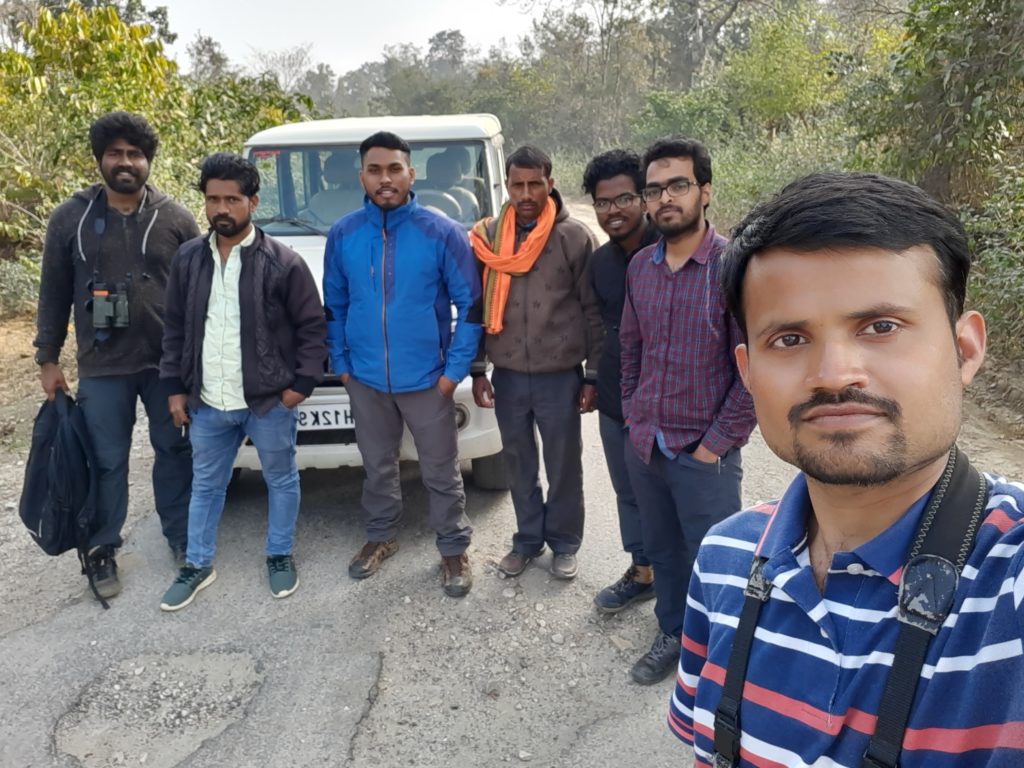 With research colleagues and support staff in the current assignment under Dr. Gopi G.V. with the Wildlife Institute of India, Dehradun (WII) at Jharkhand
With research colleagues and support staff in the current assignment under Dr. Gopi G.V. with the Wildlife Institute of India, Dehradun (WII) at Jharkhand
I love what I do because…
Initially, it was simply the opportunity to spend extended amounts of time in the wilderness, since us researchers can obtain permits to visit areas that no tourist can. As a rookie field biologist, initially it felt quite surreal that I was getting paid to travel to various parts of the country, witness and spend time with the incredible biodiversity of the nation towards working for their conservation. Passion had indeed become profession. However, over the years, having understood (and still learning to understand everyday) the complexities of issues around wildlife and forest conservation in the country, I truly realised the importance of the work that our community does. Shouldering this responsibility of being one of the messengers or spokespersons (through one’s research and conservation work) for the unrepresented trees, animals, and all non-human life, along with human communities totally dependent on forest resources – usually languishing at the periphery of our imagination – is very important to me. Conveying these nuances through my work and through regular interactions with various stakeholders is what gives me most satisfaction. Being amidst forests and wild animals, observing and photographing them and their behaviour, travelling to various parts of the country and interacting with rural India and rural life remain some aspects that I continue liking the most.
Challenges I faced..
In the field, since I have worked and am working in areas affected by armed anti-state elements and organisations, certain areas within one’s study landscape either cannot be visited (deemed too dangerous) or modern research tools such as automatically-triggering cameras, aerial unmanned vehicles (UAVs) etc. cannot be deployed. These sometimes frustratingly limit the scope of one’s study. When I was working in the Chambal River landscape in the National Chambal Sanctuary (NCS) on the nesting ecology of riverine island nesting birds (Indian Skimmer, Black-bellied Tern, River Tern among others), I was witness to how illegal sand miners ravage the River, but was unable to do anything except inform forest staff and officials, lest fieldwork and the team’s security itself be threatened. There were a couple of times when I was threatened with mobile phone confiscation and told not to take photos and videos, and once during a river survey our boat was pelted with stones, all by illegal sand miners. During such times, I have learnt to keep a low profile, inform officials, and let governmental agencies with statutory powers (forest department, police department etc.) take charge.
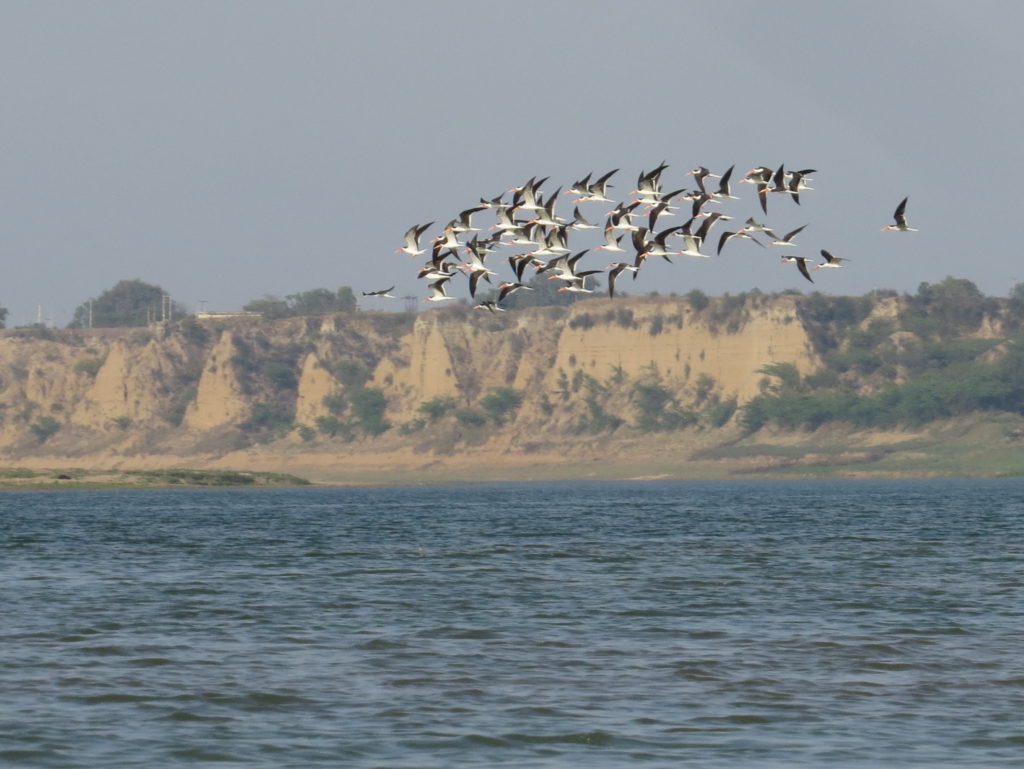 An Indian Skimmer flock in the National Chambal Sanctuary (NCS), Uttar Pradesh (2019) – I studied nest survival of riverine island nesting birds of NCS, UP during 2018-20 with WII under Dr. Bivash Pandav.
An Indian Skimmer flock in the National Chambal Sanctuary (NCS), Uttar Pradesh (2019) – I studied nest survival of riverine island nesting birds of NCS, UP during 2018-20 with WII under Dr. Bivash Pandav.
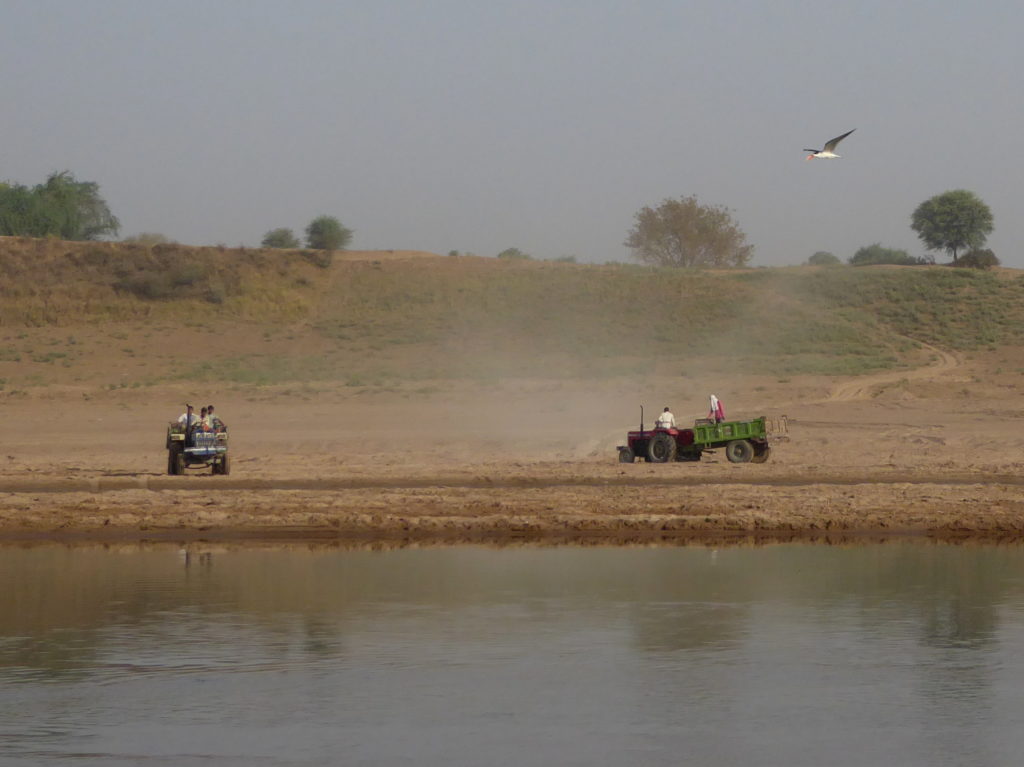 Illegal and unregulated large-scale sand mining (along with insufficient water flow during the summer season) is a huge threat to the riverine ecosystem of the NCS, affecting all nesting animals there (directly or indirectly) such as gharials, crocodiles, turtles and riverine birds such as Indian Skimmer (visible in this photograph) (2018)
Illegal and unregulated large-scale sand mining (along with insufficient water flow during the summer season) is a huge threat to the riverine ecosystem of the NCS, affecting all nesting animals there (directly or indirectly) such as gharials, crocodiles, turtles and riverine birds such as Indian Skimmer (visible in this photograph) (2018)
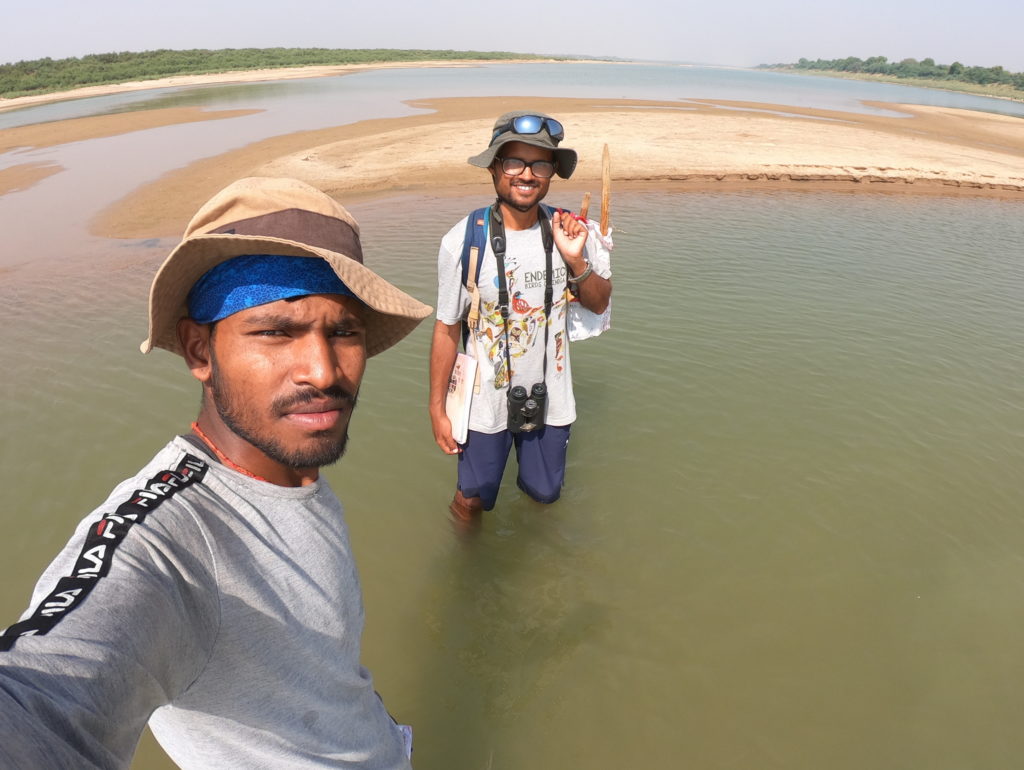 With field collaborator Atul Kushwaha in 2019 during fieldwork in NCS, Uttar Pradesh
With field collaborator Atul Kushwaha in 2019 during fieldwork in NCS, Uttar Pradesh
The nature of our work itself – requiring extended time in the field and then at the HQ writing papers and reports – allows very little time to be spent with family, unless you work closer to home. Our dog Kaalu is 13 years old now and my parents are not getting younger either. I would love to spend more time with them than I am currently able to. Considering these domain-specific realities, the relatively low entry level remuneration that a career in wildlife offers, largely benchmarked by Government of India regulations, becomes a significant challenge. Frustratingly, the rate at which increments and revisions are done is very infrequent, on an average only once every four or five years. This puts considerable strain on most early career researchers’ finances and personal lives.
My advice to young researchers is..
I think one should choose their guides/ mentors/ advisors (or Principal Investigators) very carefully. This relationship must be built on mutual trust, and the advisor must be available whenever their interventions are needed. Having good mentors who truly value you, understand your strengths and weaknesses, and direct you in making the right choices at every stage of one’s career greatly helps in realising one’s full potential. In our ornithological research, especially if dealing with conservation issues, one must try to have an open mind, in the context of which the ‘being relevant’ approach as neatly outlined by Chapman et al. (2015) seems very appealing to me.
Also, be sure to discuss, brainstorm, ask/ respond to questions about your/ their work with colleagues, peer groups and senior researchers and scientists. Like in most fields, experience is the most prized asset in wildlife biology as well. Have and build upon your own well-researched ideas, but don’t hesitate to pick brains of people and practitioners. A vibrant workplace atmosphere facilitating such exchange of ideas, discussions and collaborations is extremely essential. I cannot overemphasise the habit of reading widely and critically on all aspects of ornithology, wildlife conservation, human-birds or human-wildlife interface and interdisciplinary work (including political ecology, conservation anthropology, ecological economics etc.), not only restricting to research papers/ reports, but also perspective pieces, well-argued opinion and popular articles.
Whenever possible, it may be important to upgrade existing and learn new skills. There is nothing in this world that cannot be learnt over the internet in the form of excellent video tutorials, online courses, and shared material (such as on this website itself listing useful ornithological resources), or from friends and colleagues with expertise. This is especially true for ornithology where large databases (comprising information, photographs, audio etc. such as ebird, Birds of the World, The World Bird Database, Bibliography of South Asian Ornithology, Oriental Bird Images etc.) are freely accessible. Language may be a barrier as most material exists in English, but that too is gradually changing (just one example). Try to attend relevant workshops and conferences to not only participate or present, but also to learn from others’ works as networking and peer-group interaction is very important in our field. For e.g. I learnt about certain app-based platforms that enable data collection in the field and simultaneous entry into online spreadsheets from younger colleagues and friends Varun Kher and Orvill Nazareth, and am looking to implement in my own work. I also truly realised the importance of recording bird calls and sounds in the field from another young colleague Abdus Shakur. My bird identification skills too were largely honed in the field by regularly accompanying gifted birder friends and colleagues such as Rohit Chakravarty, Sarabjeet Kaur, Amarjeet Kaur, Harindra Baraiya, Alex Jacob and others at various stages of life.
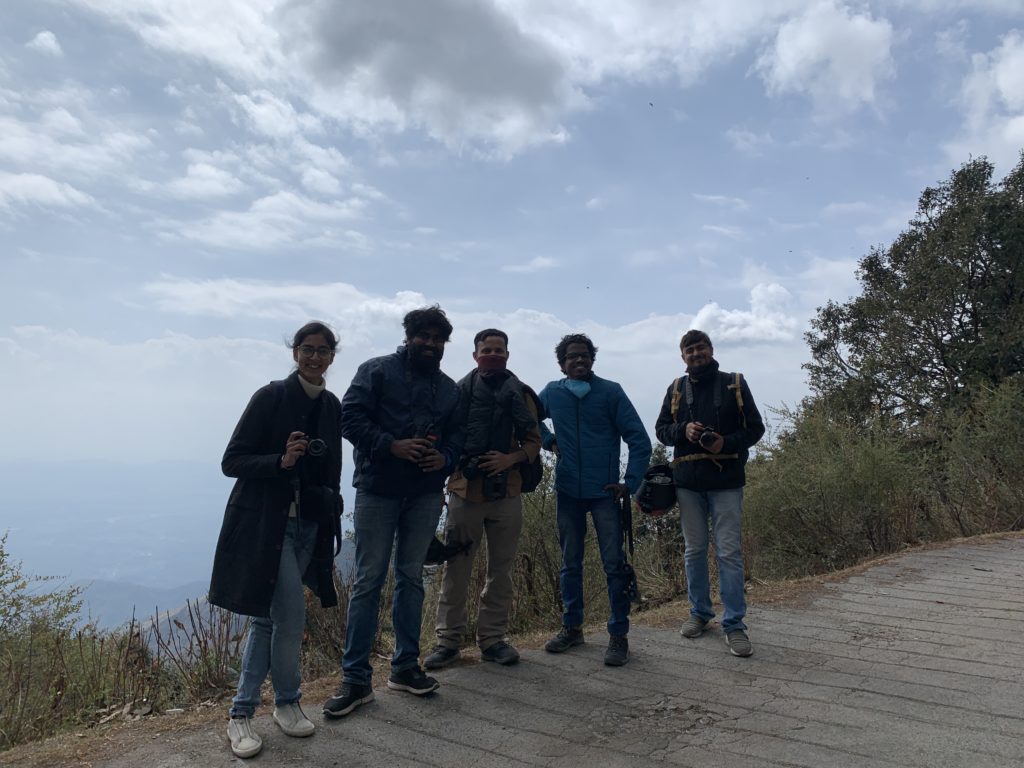 While ornithology is our profession, birdwatching opportunities with friends should not be missed; other than learning from each other while having fun, data regarding observed bird diversity too could be collected and uploaded to the global citizen-science portal eBird while birdwatching
While ornithology is our profession, birdwatching opportunities with friends should not be missed; other than learning from each other while having fun, data regarding observed bird diversity too could be collected and uploaded to the global citizen-science portal eBird while birdwatching
(Photograph credit Amarjeet Kaur, in Benog/ Mussoorie Sanctuary, 2021; left to right: Sarabjeet Kaur, Alex Jacob, Rohit Jha, Abhin N. and Harindra Baraiya)
Do not be afraid to apply to all kinds of scholarships and grant opportunities (including fully funded PhD projects in India and abroad) if they seem relevant. There are always more rejections than an acceptance, but when you do get one, it imparts a great deal of confidence and independence. The process of writing itself necessitates greater and wider reading, thereby giving clarity and structure to your ideas. If you are an absolute fresher and feel that you need some experience before figuring things out, feel free to write to senior scientists whose work you like, and check if they might need a helping hand in the form of an intern (whether in the field or for other related tasks). Trying out different things at different places with different people might help in figuring out what you may truly be interested in.
Certain simple things in the field such as ensuring that data entry happens contemporaneously with data collection, valuing field time and discipline, maintaining detailed logs in a physical diary or notebook (apart from digital records) of places visited, work done and experiences/ learning every day, noting names and contact details of people you interacted with, having project finances in order etc. all go a long way in helping one become a better and well-rounded field biologist. Also, in consultation with your superiors, do not be afraid to try out-of-the-box and inventive solutions to problems – whether in one’s research or in conservation. Those may or may not work, but you would have learnt a great deal.
Authorship on project publications (including being the corresponding author) is another thing where one must politely insist on getting one’s due. If you have collected data in a project, you have earned the right to be given the chance to become an author/ co-author on the resulting publication(s) (unless mutually and voluntarily consented to otherwise by both parties at initial stages) and contribute to other aspects such as analysing data and writing the manuscript. Ideally, authorship and authorship order must be spelt out at the planning stages of the study itself. There exist many global and (draft) national guidelines on this subject, and it is important that young biologists be aware of these and insist to superiors that they be followed.
As an ‘upper caste’ Hindi-speaking male member of our relatively small community, I have had it relatively easy in the field. But as wildlife research opportunities continue to expand both in scope and coverage, hearteningly, participation of women and those from other historically disadvantaged communities have been increasing when for a long time wildlife research was a male-dominated elite field. It is upon each one of us now – young and old – to ensure (and intervene, whenever required) that women and researchers/ support staff from diverse backgrounds feel safe and secure, both in the field and at the workplace. From an early career stage itself, we all should cultivate and practice (in and around us) a zero-tolerance attitude towards sexism, casteism and harassment of any kind from anyone, and confidently voice against any injustice to relevant decision-making authorities. We should also be keen to understand and be aware of local customs, traditions, practices of wildlife and forest resources management/ governance as these will help to suggest workable site-specific recommendations and solutions to managers. We should be as respectful and responsive to needs and concerns of persons who directly work under or with us – such as field collaborators and associates (also unsatisfactorily referred to as field assistants), volunteers and interns, forest guards/ watchers, other support staff and members of local community that we may interact with – as we would be to those of our superiors.
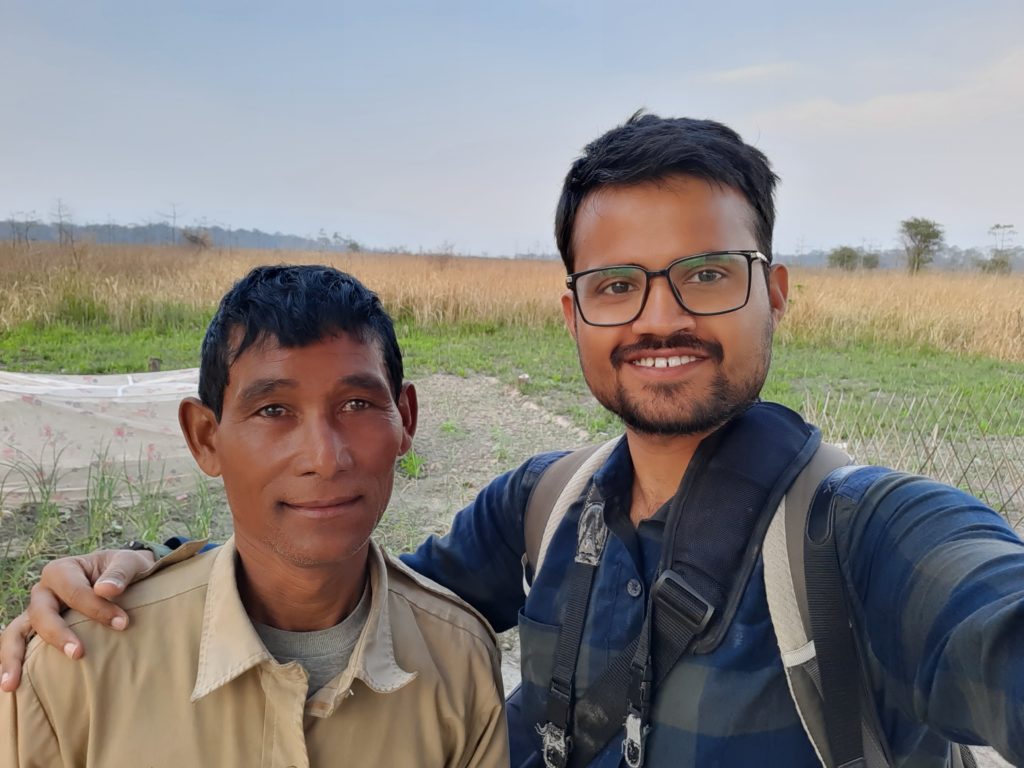 With Forest Guard and expert birdwatcher Shri. Krishna Doimari in D’Ering Memorial Sanctuary, Arunachal Pradesh while surveying for suitable Bengal Florican habitats in March 2022
With Forest Guard and expert birdwatcher Shri. Krishna Doimari in D’Ering Memorial Sanctuary, Arunachal Pradesh while surveying for suitable Bengal Florican habitats in March 2022
I also feel that one should try not to burn out due to excessive work. We need to enjoy our time on and off the field, and chill occasionally doing other activities and engaging in hobbies. News on wildlife can be quite depressing, with species extinctions, population declines, habitat degradation/ destruction observed everywhere. In the face of all this, positive news (however infrequent) must be celebrated, and learnings appropriately implemented. Everyone has their own journey, some may be early achievers while others late bloomers. But enjoying the journey is very important: we need not necessarily be a part of the rat race, while continuing to do meaningful things and relevant research that might bring along positive impacts.
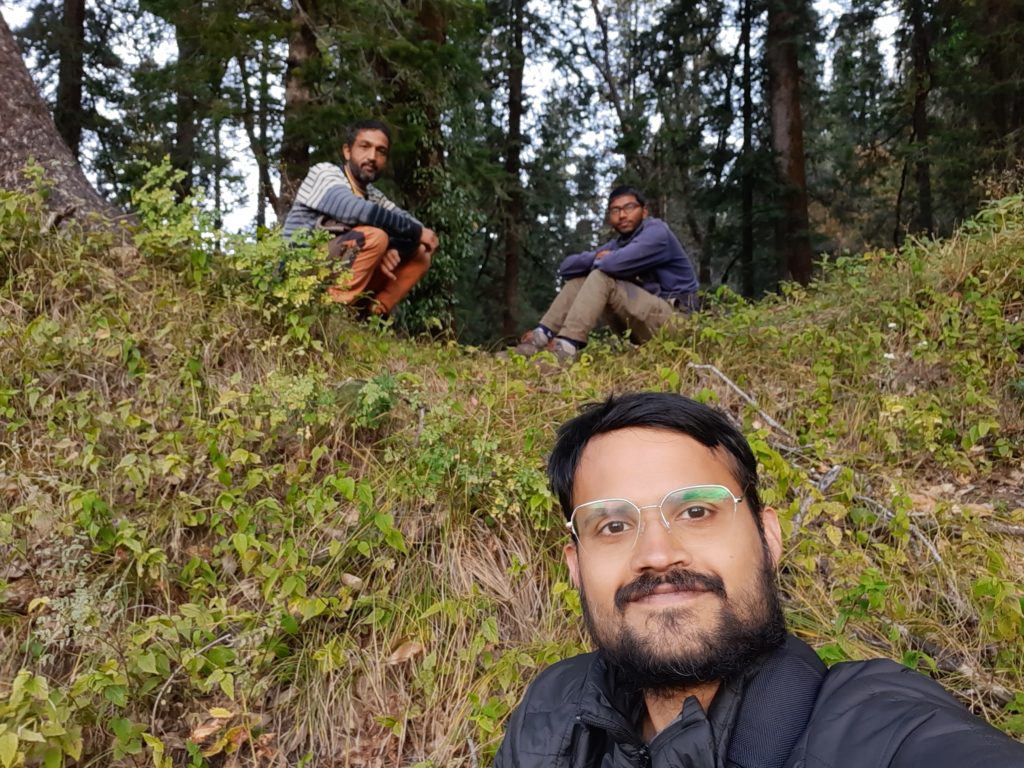 With younger colleague Abdus Shakur (top right) and local guide Shri. Ram Kumar ji (top left) at Govind Pashu Vihar Sanctuary, Uttarakhand in October 2021 while on a short assignment to assess the region’s avitourism potential
With younger colleague Abdus Shakur (top right) and local guide Shri. Ram Kumar ji (top left) at Govind Pashu Vihar Sanctuary, Uttarakhand in October 2021 while on a short assignment to assess the region’s avitourism potential
Rohit R. S. Jha
[email protected]
Senior Project Associate
Wildlife Institute of India, Dehradun
Instagram: @ro.jha
Twitter: @rrs_jha
Research Gate: https://www.researchgate.net/profile/Rohit-Jha-12
Orcid: https://orcid.org/0000-0001-6781-3194

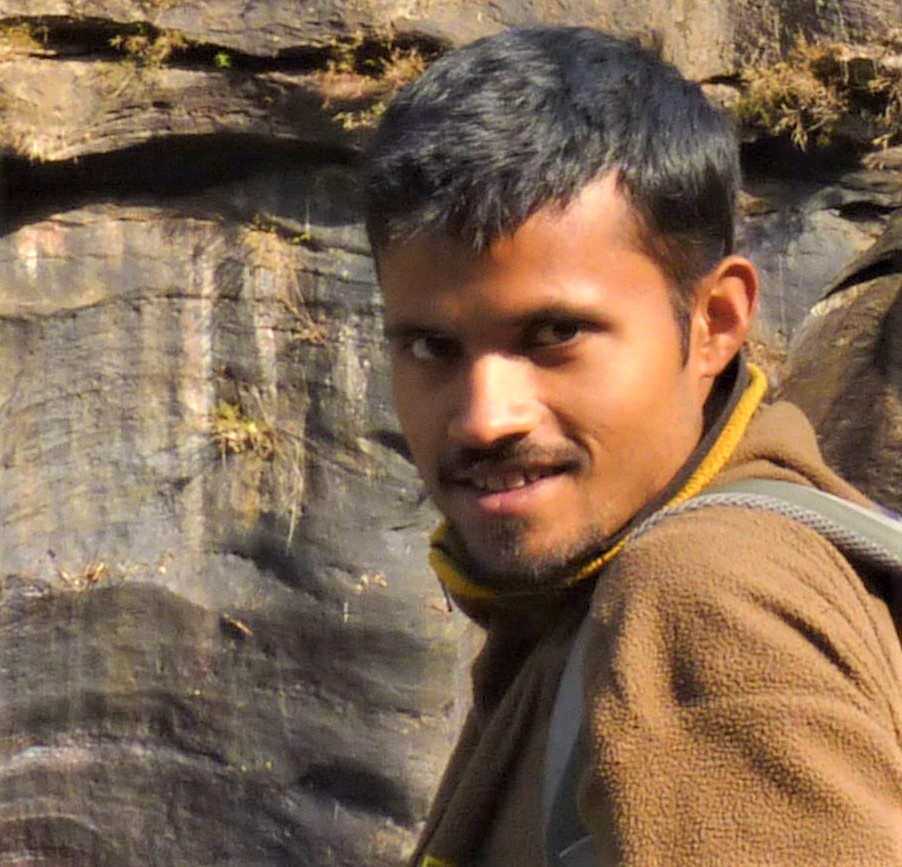
Great!